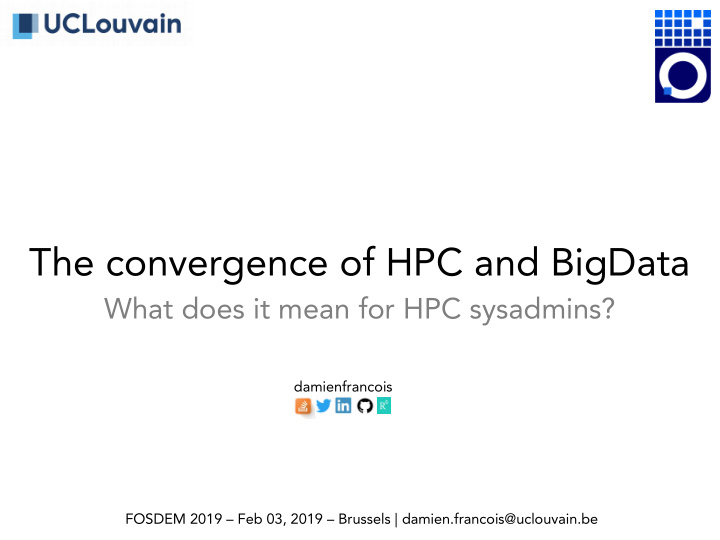



The convergence of HPC and BigData What does it mean for HPC sysadmins? damienfrancois FOSDEM 2019 – Feb 03, 2019 – Brussels | damien.francois@uclouvain.be
Scientists are never happy
Some have models but they want data Please do not ask me to explain the equations. Thanks. Pictures courtesy of NASA and Wikipedia.
Others have data but they want models Please do not ask me to explain the equations. Thanks. Pictures courtesy of NASA and Wikipedia.
Data intensive Compute intensive (HPC Dwarfs) (BigData Ogres) Dense and Sparse Linear Algebrae, Spectral PageRank, Collaborative Filtering, Linear Classifers, Outlier Detection, Clustering, Methods, N-Body Methods, Structured and Unstructured Grids, MonteCarlo Latent Dirichlet Allocation, Probabilistic Latent Semantic Indexing, Singular Value Decomposition, Multidimentional Scaling, Graphs Algorithms, Neural Networks, Global Optimisation, Agents, Geographical Information Systems The Landscape of Parallel Computing Research: A View from Berkeley Fox, G et al Towards a comprehensive set of big data benchmarks. Krste Asanović et al EECS Department University of California, Berkeley In: BigData and High Performance Computing, vol 26, p. 47, Technical Report No. UCB/EECS-2006-183 December 18, 2006 February 2015 I did not invent that. Pictures courtesy of Disney and DreamWorks.
Data intensive Compute intensive (BigData) (HPC) Cloud Clusters This is caricatural a little inaccurate but it saves me tons of explanation. Pics (c) Disney and Dreamworks
Data intensive Compute intensive (BigData) (HPC) Cloud Clusters Instant availability Close to the metal Self-service or Ready-made High-end/Dedicated hardware Elasticity, fault tolerance Exclusive access to resources This is caricatural a little inaccurate but it saves me tons of explanation. Pics (c) Disney and Dreamworks
Data intensive Compute intensive (BigData) (HPC) Cloudster(?) The word ‘cloudster’ does not exist. I made it up. Not related to shoes. Pics (c) Disney and Dreamworks
Now all Cloud providers offer HPC services
What should Academic HPC centers do? Answer on next slide. Please be patient.
They should add Cloud-related technologies to their offering.
Cloud stack Cluster stack Web Mobile Infra., Platform, Soft. BigData user ecosystem HPC user ecosystem Resource manager Resource manager MapReduce/Spark NoSQL + DFS MPI //FS Block storage VMs + VNets System Hypervisor OS (with RDMA, Perf monitoring) OS Hardware Commodity High-end entry-level procs, 10Gbps net, costly procs, 100Gbps net, SSDs, harddisks, medium-size RAM, etc. hardware accelerators, etc.
Nikolay Malitsky, Bringing the HPC reconstruction algorithms to Big Data Platforms, New York Data Summit, 2016
5 paths to follow
1 Virtualization More user control, more isolation 1.a Private Cloud on HPC Deploy virtual machines inside a job allocation with, for instance, pcocc. 1.b HPC On Demand & HPC as a Service Deploy a cloud and install the HPC stack inside virtual machines allocated for each project/user with, for instance, TrinityX. 1.c Containers Run jobs in containers, with for instance Singularity, Shifter, or CharlieCloud.
2 Cloud bursting Elasticity for the cluster Provision virtual machines in a cloud and append them to the cluster resources. Example with the Slurm resource manager:
3 Additional storage paradigms Solve the ZOT fles problem and increase external share-ability 3.a Object storage Deploy an object store, e.g. HDFS, but also Swift or Ceph, either on a dedicated set of machines close to the cluster and with external connectivity or on the hard drives of the compute nodes. 3.b Hadoop connectors Install a ‘connector’ on top of BeeGFS, Gluster, Lustre, etc. to offer a HDFS interface. 3.c NoSQL Deploy an ElasticSearch, a MongoDB, a Cassandra, a InfuxDB, and a Neo4j cluster on separate hardware close to the cluster. There are many more other options for NoSQL databases.
4 Additional programming paradigms Offer new libraries, mid-way between MPI and job arrays: HPDA 4.a Standalone MapReduce or Spark ... 4.b Deploy a Hadoop framework inside allocation Using for instance MyHadoop, a “Framework for deploying Hadoop clusters on traditional HPC from userland” 4.c Disguise the scheduler as a Hadoop platform Using a tool that deploys a Hadoop framework by submitting jobs, then report back to the user and allow them to submit MapReduce jobs, for instance HanythingOnDemand, HAM, or Magpie
4 Additional programming paradigms Offer new libraries, mid-way between MPI and job arrays: HPDA 4.d HPC and BigData scheduler colocation Take advantage of the elasticity and resilience of the Hadoop framework to deploy Yarn on the idle nodes of a cluster and update the Yarn node list upon job start or termination. Or dedicate a portion of the cluster to Yarn/Mesos. 4.e Unifed BigData/HPC stack One day? Intel, IBM working on that. Will it be FOSS? <Spoiler> Probably not. But generates a lot of fuss. </Spoiler>
5 Web and Apps Going beyond SSH and the command line, adding interactivity 5.a Web-HPC Allow users to submit jobs through web interfaces, but also to use Web-based interactive scientifc interpreters such as RStudioServer and JupyterLab, and notebooks, etc. 5.b Ubiquitous access to data Let the user access data and results from the Web, an App, or a Desktop client, with for instance NextCloud. I personnaly prefer my terminal.
The “Cloudster” Outbound GridFTP , Sqoop NextCloud Data transfer nodes Web nodes Login nodes RStudio et al Submit job scripts or or containers or VMs or MapReduce or Spark jobs Databases nodes Management Fast interconnect Nodes Parallel flesystem With a Hadoop connector High-memory Accelerated RAID SSDs compute nodes compute nodes compute nodes Run baremetal or container or VM The Ultimate Machine.
Scientists will be happy Well, I hope. Thank you for your attention.
Recommend
More recommend